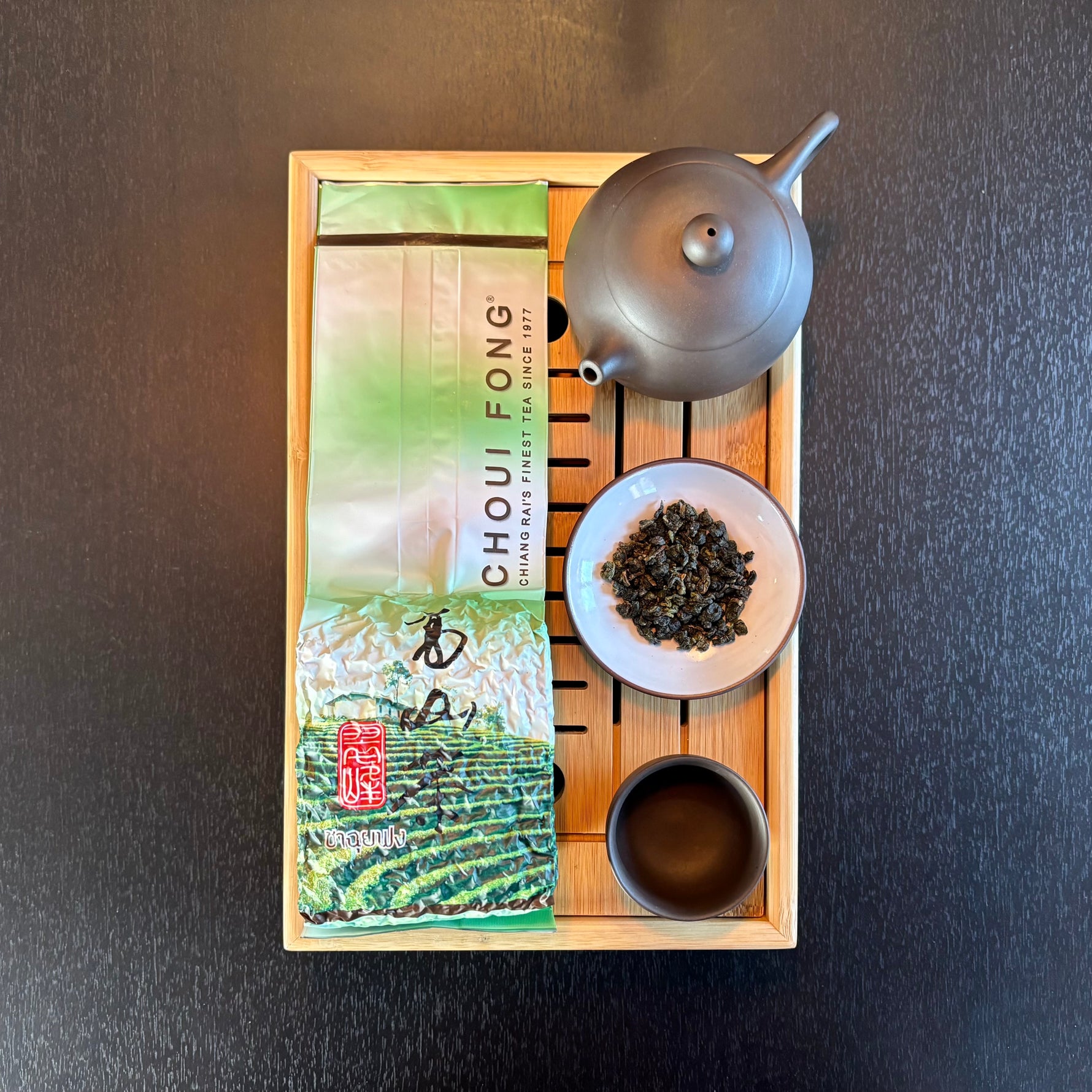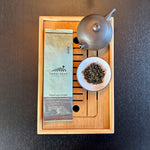Subscribe and save 10%!

Ruan Zhi Oolong Tea (Oolong No. 17) | Exclusively delicate tea from the mountains of northern Thailand
Beställningar som inkommit innan söndag morgon packas sön-mån.
Se våra leveransvillkor.
In stock - Ready to be shipped
Share
Origin:
This Oolong tea comes from the beautiful mountain landscapes up in northern Thailand. The type of tea bush from which the teas are made is imported from a tea research center in Taiwan and is called Ruan Zhi (also Oolong No. 17) - which means "soft stem". These tea bushes and the classic Taiwanese way of preparing the tea leaves give a wonderfully full, round, floral and sweet taste. It has become a favorite of many tea drinkers in the region.
The Ruan Zhi variety is ironically hardly found in Taiwan but has become a popular variety among the few producers in the mountainous regions of northern Thailand, making the tea specific to its area. The reason for this is that the tea research center was one of Thailand's so-called Royal Projects, a series of development projects carried out by Thailand's King Rama IX with the aim of preserving the nation's nature and supporting the agriculture of the mountain people. Today, more than 5 mountain regions in the country are engaged in the cultivation and production of high-quality tea.
Distinctive features:
The Ruan Zhi tea bush (Oolong No. 17) is, as mentioned, only found in the region of northern Thailand. The tea produced from the Ruan Zhi bushes is unusually round and full-bodied in taste with a pleasant floral sweetness. It is a favorite for those who know it. The producer of this particular tea is called Choui Fong and is a top producer in the area. Thanks to the good growth, they have established majestic plantations with several exclusive cafes that you can visit and try everything possible made from the tea bush: tea leaf salad - made from both fermented and fresh tea leaves (really good), cheesecake made from green tea, classic Chinese steamed buns flavored with tea and the opportunity to taste all their different teas; oolong 12 & 17, jasmine tea, oolong with osmanthus, etc.
This producer's expertise in classic Taiwanese tea making combined with their special tea bush with extra soft stems produces a truly refreshing and delicate tea with a sweetness and complexity of flavor that is hard to find elsewhere.
Flavor profile:
A soft and round oolong tea with a floral sweetness that becomes more and more evident with each brewing. Almost completely devoid of bitterness compared to 400 Year Old Organic Tea and Seohopene Ancient which are so-called Pu'ehr teas, but also compared to other oolong teas which are often more bitter than this Ruan Zhi Oolong No. 17.
Light amber colored brew.
How to brew the tea:
Here's how to brew Oolong tea to bring out its rich and complex flavors:
-
Measure the tea : Since oolong can steep a little longer without becoming too bitter, I usually brew oolong in a half-liter teapot. It still takes a couple of brews, but much less often than if you brew in a small gaiwan, which usually holds a maximum of 2 dl. I usually add 1-1.5 tablespoons of oolong to a half-liter teapot.
If you would rather drink from a smaller teapot/gaiwan, measure out 5–7 grams of Oolong tea for 150–200 ml or adjust the amount to taste. -
Rinse the tea : Pour hot water (90–95°C) over the tea leaves and immediately pour off the water. This "rinses" the tea and opens up the leaves. When brewing in a pint jug, I usually skip this step.
-
Brewing : Add hot water again and steep for 30–60 seconds for the first brew. For subsequent brews, you can gradually increase the steeping time (10–20 seconds at a time). If you brew in a half-liter jug, you can leave the leaves in for longer - until you have finished drinking, or pour the brew into a second teapot free of tea leaves after the selected brewing time.
-
Serve and enjoy : Pour the tea into a cup and enjoy its balanced flavor. Oolong tea can be brewed multiple times, and each brew reveals new nuances.
Tip: When brewing in a half-liter jug, use a larger strainer where the tea leaves are allowed to unfold - this way the teapot is easier to keep clean as it is free of loose leaves that can otherwise be difficult to get out due to the design of the teapot.
Vill du odla ditt eget te?
Här hittar ni de olika sorters härdiga tebuskar vi har - för frilandsodling av ditt eget te. Plantorna och fröerna vi säljer använder vi själva till våra egna teodlingar i Marieholm och intill Kävlingeån, zon 1 i blåsiga Skåne.

Tebuske 'Tieguanyin': Härdig sort (Camellia sinensis var. sinensis) 40-50 cm
516 SEK
Unit price perTebuske 'Tieguanyin': Härdig sort (Camellia sinensis var. sinensis) 40-50 cm
516 SEK
Unit price per
Tebuske 'Longjing 43': Härdig sort (Camellia sinensis var. sinensis) 40-50 cm
476 SEK
Unit price perTebuske 'Longjing 43': Härdig sort (Camellia sinensis var. sinensis) 40-50 cm
476 SEK
Unit price per
Tebuske 'Kymin': Härdig sort (Camellia sinensis var. sinensis) 30-40 cm
300 SEK
Unit price perTebuske 'Kymin': Härdig sort (Camellia sinensis var. sinensis) 30-40 cm
300 SEK
Unit price per
Tebuske 'Kolkhida': Härdig sort (Camellia sinensis var. sinensis) 30-40 cm
300 SEK
Unit price perTebuske 'Kolkhida': Härdig sort (Camellia sinensis var. sinensis) 30-40 cm
300 SEK
Unit price per
Tebuske 'Georgian Classic': Härdig sort (Camellia sinensis var. sinensis) 30-40 cm
300 SEK
Unit price perTebuske 'Georgian Classic': Härdig sort (Camellia sinensis var. sinensis) 30-40 cm
300 SEK
Unit price per
Tea bush 'Tearoma®': Hardy variety (Camellia sinensis) 50-60 cm
236 SEK
Unit price per
Tea Plant (Camellia sinensis)
From 236 SEK
Unit price per
Tea Plant (Camellia sinensis)
From 260 SEK
Unit price per
Tea bush (Camellia sinensis)
52 SEK
Unit price per- Choosing a selection results in a full page refresh.
- Opens in a new window.




















